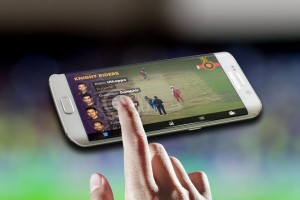SVG Europe Sit-Down: Alston Elliot’s Nick Baily on the need to use specialist graphic operators and the growth of 4K
Alston Elliot has come a long way since being founded in 1992, initially to provide a computerised graphics and data solution to the BBC for its coverage of Test cricket and World Snooker events. Just last month, Alston Elliot and Sixty announced that they will combine their unique sports graphics expertise to provide Sixty’s interactive clickable on-air graphics solution, Ease Live, for immersive, televised cricket viewing. So, with such a fresh innovation in place, that was the place to start our conversation with Nick Baily, CEO Alston Elliot (aegraphics.tv)…
Can you talk us through the development and benefits of ‘Ease Live’?
We see a growing demand for OTT products and our Ease Live cricket project is a response to that, in partnership with Sixty.
The landscape in terms of viewing content is shifting and that’s both from a geographical and generational perspective. India, one of the markets where we’re very prominent is a good example. Cricket, as most people will know, is their major sport and a significant number of viewers consume the coverage on a smartphone. As anyone with children will testify, that generation also consumes the majority of their content using a mobile device. The demand is there so it makes sense to tailor the experience to best suit the device that they’re using.
Our partnership with Sixty currently focuses on cricket which makes sense given our prominence in the global cricket market and our experience of the data and analytics involved in the sport. The app allows users to customise their own viewing experience, offering multiple replays, highlights and, crucially, interactive graphics, allowing those who are so inclined to drill down into much more detailed data sets than are often displayed on a traditional broadcast. The interactive element can also be tailored to link to social media and sponsored elements.
What do you see as the biggest challenges you face today?
Demand. Obviously that stems from a positive insofar as we have had a particularly successful 12 months, managed to secure some major contracts and are chasing others in the four very different markets that we occupy. The crucial thing for us is remembering how and why we’ve won the work that we have and ensuring that any new projects can be delivered to our exacting standards. This sometimes means saying “No” to work – which can be something of an alien concept to those of us in commercial roles, but you have to look at the broader landscape and make the right call so as to not overstretch and under-deliver.
For a company like AE, where we’re providing services at the frontline, our people are our most important commodity. Finding the right people with the necessary skillsets is a constant challenge and is magnified as the business grows. The fact is that we’re delivering a wider and more diverse range services under the banner of AE Graphics than ever before and being able to offer the right level of management and support to those services is of paramount importance.
Graphics have come a long, long way since simply captioning a broadcast. Is there one innovation that stands out in your mind as the bottom line of innovation?
AE has been operating in the market for 25 years now so I’d agree that we’ve seen a fair bit of change in that time. It’s difficult to pinpoint one particular innovation as the bottom line, but there are trends that have permeated the industry and changed the game. One such element is the level of data now expected as part of a standard sports broadcast. Graphics and data have inevitably gone hand in hand from the start, but the number of enhanced data services has grown exponentially in the last five years and now heavily influences the way that we design, build and service our range of products.
The appetite for AR has also been at the forefront of the industry in recent times and that’s something that we’ve worked hard to stay abreast of. Our R&D team has developed relationships with all of the major players to get some understanding of the technical challenges associated with each and how we can integrate into our workflow. Spidercam Vector is a good example, where we were one of the first graphics companies to work with them and we have several exciting upcoming projects where we’ll be exploring ways of using that unique canvas to better present rich streams of in-match data.
OTT will be a focus for us over the coming years as broadcasters and federations look to engage with their consumers in a more hands-on fashion. We feel that our somewhat unique position in the broadcast chains places us in an enviable position to help service OTT products.
As we all know a key innovation over the coming years will be OTT and how broadcasters and federations look to engage with the fans. We are keen to utilise our unique market position to be able to deliver OTT services in tandem with traditional broadcast offerings and so strategic partnerships such as our recent agreement with Sixty are important to us.
Programme directors and producers have become more specialised in their craft. Do the same deeper insights into sports apply to graphics operators, too?
Absolutely. Our recruitment policy has always centred upon identifying bright, IT literate sports fans with a genuine passion and understanding of the sports that they are covering. We know this is something that our clients like because they tell us often enough and we’ve come to be recognised for providing specialists for certain sports. It stands to reason that a person actively engaged and enthusiastic about the sport is far more likely to offer graphics that enhance the broadcast and help tell the story of an event. Our best results are always achieved when the operators are viewed as a trusted part of the production team.
Interestingly our policy has begun to influence the way that graphics operators are viewed in some of the newer markets that we are operating in. Australia is a good example of this where the role of graphics operator was traditionally filled by the PA/DA. After securing our first contract in the region to cover A-League football in 2013, we provided a team of operators that were passionate and knowledgeable about the game and the production teams noticed the benefit almost immediately. This recognition has filtered down and is now viewed as a standard requirement for operators across all sports.
Everyone is seeking to reduce costs. How can this be achieved with regards to the broadcast graphics environment?
I’d agree that everyone is keen on reducing costs but, unfortunately, they are not so keen on reducing the range of services and, in fact, are often looking to extend them! As I said previously, the scope of a traditional graphics service has been extended and our clients expect much more as standard when they engage you as a graphics supplier these days.
It essentially boils down to gaining the best utilisation possible out of the resources that you are providing for a job. Reduction in costs also makes it more difficult to justify the necessary investment in new technology and hardware that we need to make. In certain markets that we are operating in, the model is to offer long term five or six year deals which makes it easier to present a business case for investment – but such deals are few and far between in our home UK market.
What will the growth of 4K (or higher) mean to you?
We have been involved from the start as far as 4K graphics go. We produced 4K broadcast graphics with NEP Australia for Star Sports’ host broadcast coverage of the 2015 Cricket World Cup and have been supplying UHD graphics for BT on the vast majority of their football, including Premier League, and rugby union coverage since August of last year.
It is fair to say that it has been a steep learning curve for us, as it has for other providers. The lack of standardisation around formats and the complications associated with IP delivery have made it a challenging process – but one that we are committed to. In the UK market, we have upgraded four of our graphics OB vehicles to be UHD-ready meaning that we are in an ideal position to assist our clients as their UHD plans evolve.
Does the growth of second screens affect your work for broadcast applications?
The growth of second screen doesn’t really affect our core service, adversely – it actually extends it. As alluded to when talking about Ease Live and our partnership with Sixty, we see this area as complementary to our more traditional scope of work. When you consider that we are already onsite, hold extensive data for the event and are usually the guardians of the on-screen look, it makes logical sense that we should extend these elements to second screen.
All broadcasters and governing bodies are keen to tailor a service for their consumers across all platforms. We’ve been in the business for many years of building analysis and touchscreen tools for TV pundits to use on screen and now we have the opportunity to make the same tools available to the armchair fans.



